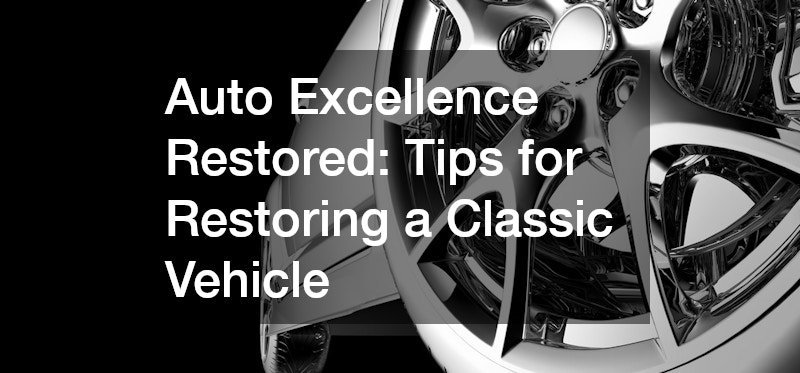
Bringing a vintage car back to life is equal parts planning, patience, and problem-solving. The most successful projects start with a clear destination and a realistic map for getting there. You will balance originality, drivability, and budget while learning new skills along the way. With the right sequence and a steady cadence, the process becomes rewarding instead of overwhelming.
Define Your Restoration Vision
Begin by deciding what “finished” actually means for you and your family. Are you chasing concours correctness, period-correct drivability, or a tasteful restomod with modern safety and comfort? Write down a short vision statement and a prioritized features list so every decision ties back to that plan. When tradeoffs arise, return to your list and let it steer your choices.
Your starting point influences the whole journey, so choose a car you can support with parts, documentation, and community. Scout owner forums, marque clubs, and local classifieds to understand parts pricing and typical problem spots. You can also walk lots that handle used car sales to spot potential donor vehicles or a well-preserved project that needs mostly cosmetic attention. The more you know before buying, the fewer surprises you will face after it arrives.
Budget, Timeline, and Financing
Next, translate your vision into a staged budget and timeline that covers purchase, teardown, mechanical systems, body, interior, and final detailing. Assign target costs to each stage, then add a contingency because hidden corrosion and seized fasteners tend to appear. If you prefer to spread costs out, explore affordable auto loans that match the project pace and protect cash flow for parts and tools. A calm, funded plan keeps momentum steady through the inevitable slow weeks.
Schedule your project like any other long-term goal. Block recurring weekend hours and one focused evening for research, ordering, and prep. Track progress in a simple spreadsheet with tasks, suppliers, and notes so you never lose the thread. When the timeline is visible, you will resist scope creep and keep the finish line within reach.
Build Your Support Network
Few projects succeed in isolation, so line up trusted pros for specialized tasks and guidance. Cultivating a relationship with a helpful local auto repair shop provides diagnostic support, lift time, and machine services when you hit a wall. Introduce yourself, be clear about your goals, and ask how best to book short service windows without disrupting their schedule. A reliable shop partner saves time and prevents expensive do-overs.
Round out your roster with a machine shop, a trimmer, and a paint professional, even if you intend to do most work yourself. Having vetted experts on call turns big roadblocks into manageable speed bumps. Ask each specialist how far in advance to book and what prep work you should handle before dropping off a component. Respecting their workflow will earn you responsive help when you need it most.
Choose The Right Candidate Car
Your target model may exist in three conditions: neglected but complete, partially restored, or nicely preserved. Inspect each candidate with a checklist for rust, collision history, drivetrain completeness, and paperwork. Lots that focus on used car sales can be useful for comparing trim variations and spotting common wear patterns across years. A complete, straight car almost always costs less to finish than a cheap shell missing key components.
Confirm numbers on body tags, engine castings, and major assemblies if originality matters to you. Look for signs of poor previous repairs, like mismatched fasteners, stacked shims, or distorted panel gaps. Photograph everything and build a parts list as you inspect, then estimate the cost to close gaps. The best project is the one you can finish with confidence and pride.
Workshop Setup and Supply Chain
Set up a safe, efficient workspace before you turn the first wrench. Good lighting, stable jack stands, and labeled bins eliminate the frustration that can derail momentum. Arrange shelves for fluids, rubber items, and fasteners so each system gets its own section. Establish vendor accounts for quick ordering and ask about delivery schedules that keep your work flowing.
Map your consumables so you never run dry during critical steps. If you live where bulk fuel is common, coordinate with local service providers who handle oil delivery to ensure you have break-in and high-zinc blends on hand when an engine first fires. Keep brake cleaner, penetrant, tapes, and heat-shrink within arm’s reach to reduce wasted steps. A tidy bench and stocked shelves make nights in the garage feel productive.
Establish a Mechanical Baseline
Start with safety systems and fundamentals so every later improvement pays off. Evaluate the engine, transmission, driveshaft, and differential for leaks, noises, and lash before chasing minor cosmetic items. When compression, oil pressure, and coolant flow meet spec, the rest of the car is worth your time. Build a checklist and work methodically from front to back.
If compression is uneven or noises suggest deeper wear, plan targeted engine repairs before any tuning or dress-up. Replacing wear items like timing sets, pumps, and gaskets early prevents repetitive teardown later. Document clearances and torque values in a build log you can reference during break-in. A strong core keeps the project fun when you graduate to finer details.
Bodywork, Rust, and Paint Planning
Cosmetics are the last step for many builders, but planning them early prevents surprises. Document rust, filler thickness, and previous body seams with a magnet and a thickness gauge. Decide where you will weld patches and where replacement panels make better financial sense. Accurate estimates up front protect your budget later.
Even if you plan your own sanding and blocking, it pays to consult a respected local auto body shop about sequencing and materials. They can advise on primers, seam sealers, and corrosion protection that match your climate and driving plans. Ask about their lead times and what level of prep they prefer when a customer brings a vehicle in. A great finish grows from clear expectations and patient surface work.
Frame, Suspension, and Alignment
Underneath the shine, geometry decides how the car feels and how tires wear. Inspect rails, crossmembers, and mounting points for prior hits and fatigue. Measure diagonals and confirm that suspension pickup points are true before you add power or sticky tires. Fixing structure first keeps parts from fighting each other.
Shops that specialize in straightening and measuring unibody or ladder frames can be found among reputable auto collision shops in your area. They use fixtures and laser systems to realign what time and accidents have moved, restoring crisp handling and predictable braking. Once the base is square, you can dial in springs, shocks, and bushings for the ride you want. Confidence grows with each mile when alignment is right.
Fuel, Lubrication, and First Start
Old cars reward careful fluid choices and gradual break-in. Match fuels and octane to compression and timing, then pair oils to bearing clearances and cam profiles. Priming systems, checking for leaks, and verifying pressures before the first fire-up prevents expensive damage. Patience here pays huge dividends.
To keep the process smooth, coordinate needed quantities with a supplier that offers timely oil delivery so your garage never runs short during break-in and early shake-down miles. Keep spare filters, crush washers, and drain plugs on hand so you can change fluids quickly after the first heat cycles. Record temperatures, noises, and pressures during test runs to catch issues while they are small. A measured approach builds trust in the machine.
Body and Paint Execution
When metal is sound and panels are true, you can commit to color. Realistic timelines and proper curing windows mean you should not rush this stage to chase a show date. Protect masked edges, monitor booth cleanliness, and resist shortcuts on sanding blocks. The mirror you see later is created now.
Even if you do most prep at home, plan a final inspection with your chosen local auto body shop before the spray session. Their trained eyes catch waves and pinholes that amateurs miss, which saves money and grief down the road. Agree on how defects will be corrected and when you can safely reassemble trim without marring fresh surfaces. A calm, methodical finish makes the whole project feel complete.
Electrical Comforts and Subtle Upgrades
Reliability improves when you give electricity clean paths and clear instructions. Replace weak grounds, consolidate fuses, and add relays where loads demand them. Use factory-style sheathing and connectors so the bay looks appropriate for the era. Testing one circuit at a time prevents mystery faults later.
Some upgrades require professional tools and experience, which is why periodic visits for auto electrical repair can be a smart investment. Specialists can integrate hidden modern features like solid-state voltage control or safer fan circuits without disturbing period looks. Ask for labeled diagrams and keep spares of unique relays or modules in the glove box. A tidy, modernized system supports enjoyable, worry-free driving.
Parts Sourcing and Donor Strategy
Old parts supply is both a treasure hunt and a negotiation. Learn which components must be date-coded to the car and which can be improved with modern equivalents. Swap meets, online forums, and regional salvage yards provide possibilities if you arrive prepared with measurements and part numbers. A rolling cart, gloves, and a flashlight can turn a long day into a good haul.
Do not overlook reputable stores that handle used car sales when searching for donor vehicles with the exact axle, transmission, or interior trim you need. Buying a whole parts car can be cheaper than chasing individual components, and you can recoup costs by selling leftovers to the community. It also lets you mock up assemblies before committing to permanent changes. Smart sourcing shortens timelines and reduces waste.
Paint Protection and Detailing
Fresh paint benefits from gentle care in its early life, and thoughtful detailing preserves the finish for years. Start with soft mitts, pH-balanced soaps, and separate buckets for wash and rinse. Avoid harsh chemicals until the coating fully cures. A covered, dust-free space prevents micro-scratches before the first show.
Ask detailers who work closely with auto collision shops about film patterns, ceramic coatings, and proper curing windows. Protective film on the nose and rocker areas saves you from rock chips on the first long drive. Maintain a simple schedule for washes and quick detailer touch-ups after each trip. Pride of ownership grows with every gleam.
Testing, Tuning, and Shakedown
The first hundred miles reveal more than the last hundred hours in the garage. Vary speeds, listen for new noises, and check fasteners after each loop around the neighborhood. Little issues often surface as hoses seat and gaskets conform. Carry tools, fluids, and a notepad so you can log and fix items quickly.
Use a trusted local auto repair shop for post-assembly checks such as four-wheel alignment, brake balance, and emissions verification where required. A professional road test can confirm your impressions and suggest small tuning changes. Treat this stage as a learning loop rather than a pass-fail exam. The goal is a car that feels better every time you drive it.
Ongoing Maintenance and Service Rhythm
Restored vehicles thrive on predictable, gentle care. Keep a dedicated logbook for oil changes, valve checks, and torque inspections so nothing slips past. Stock filters, belts, and a few common gaskets to avoid downtime during peak driving season. A little planning makes weekends about cruising instead of chasing parts.
When jobs exceed your time or tools, lean on reputable teams for efficient local auto repairs that keep the calendar moving. You can handle the routine and cosmetic tasks while pros manage complex adjustments or inspections. This blended approach protects momentum and lets you enjoy the car more often. Reliability is a habit as much as a specification.
Climate Control and Seasonal Readiness
Classic cars experience big swings in temperature and humidity, so plan for seasonal prep. Inspect seals, test heater cores, and verify fan operation before the first cold snap or heat wave. A comfortable cockpit keeps family members smiling during surprises. The more adaptable the car, the more miles it will see.
Warm-weather cruising should feel effortless, which is why you will want to revisit air conditioning performance after the first long drives. Monitor vent temperatures, compressor cycling, and idle quality at stoplights. If anything feels off, return to vacuum levels, charge amounts, and condenser cleanliness. A small tweak today prevents big frustration later.
Engine Refinement and Longevity
Engines improve with careful tuning, planned heat cycles, and steady maintenance. As miles accumulate, consider a second round of carb or fuel map adjustments to sharpen response. If a noise or vibration appears, catch it early with a stethoscope and oil analysis. Your patience and notes are tools as powerful as any wrench.
Should new findings point to deeper issues, schedule focused engine repairs while the symptoms are mild and clear. Correcting small leaks, bushing wear, or a lazy lifter now prevents collateral damage. Each step builds confidence for longer trips and spirited mountain runs. Longevity is earned in these details.
Financing the Finish and Protecting the Investment
As the car nears completion, update your budget and evaluate the last purchases you need for polish and protection. If a final round of parts would push cash uncomfortably tight, consider short-term auto loans that keep momentum without risking household stability. Read terms carefully and set a payoff plan tied to your calendar. The last ten percent often requires the most discipline.
Once complete, secure agreed-value insurance and take new photos for documentation. Prepare a simple binder with build sheets, paint codes, alignment specs, and wiring diagrams so any future service is faster. Should life priorities change, well-organized records make selling easier and more rewarding. Clarity preserves both money and memories.
Celebrate the Journey and Keep Driving
When the car is sorted, make a tradition of weekly drives and monthly checks. Attend a few events to meet fellow owners and learn what they do to keep miles enjoyable. Share rides with family members so the project becomes a shared story rather than a solitary achievement. The best restorations create moments that outlast the parts list.
With patience, planning, and a willingness to learn, your vintage machine can be both beautiful and dependable. Keep your partnerships strong with a trusted local auto repair shop and a shortlist of specialists who know your car. Use targeted help for auto electrical repair, body finishing, and chassis alignment when precision matters most. Do that, and your classic will deliver the smooth idle, crisp response, and head-turning presence you imagined on day one.




